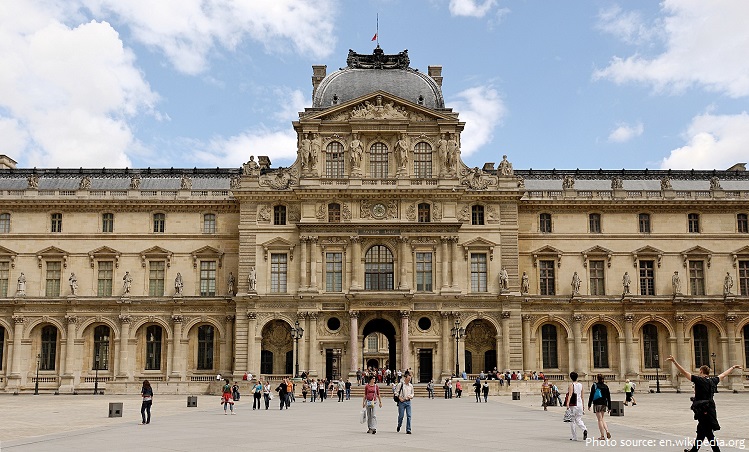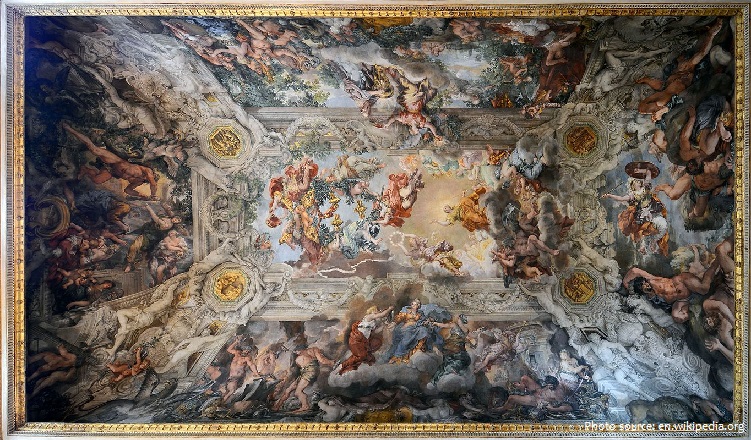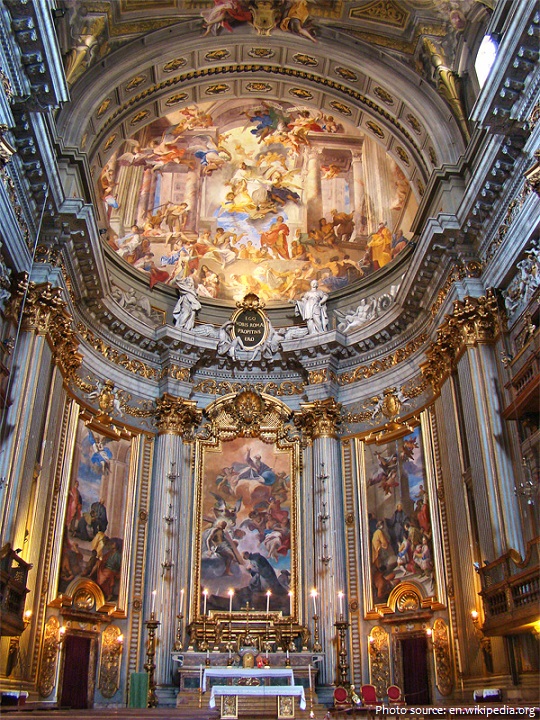
The Baroque is a style of architecture, music, dance, painting, sculpture, poetry, and other arts.
Derived from the Portuguese barroco, or “oddly shaped pearl,” the term “baroque” has been widely used since the 19th century to describe the style in Western European art that flourished from the early 17th century until the 1740s.
The work that distinguishes the Baroque period is stylistically complex, even contradictory. In general, however, the desire to evoke emotional states by appealing to the senses, often in dramatic ways, underlies its manifestations. Some of the qualities most frequently associated with the Baroque are grandeur, sensuous richness, drama, vitality, movement, tension, emotional exuberance, and a tendency to blur distinctions between the various arts.
The period’s most notable practitioners were Annibale Carracci (see Carracci family), Caravaggio, and Gian Lorenzo Bernini. A spectacular example of the Baroque arts is the Palace of Versailles. In music, the Baroque era is usually considered to extend from c. 1600 to c. 1750, when such significant new vocal and instrumental genres as opera, oratorio, cantata, sonata, and concerto were introduced and such towering composers as Claudio Monteverdi, J.S. Bach, and George Frideric Handel flourished.
Baroque architecture is a highly decorative and theatrical style which appeared in Italy in the early 17th century and gradually spread across Europe. It was originally introduced by the Catholic Church, particularly by the Jesuits, as a means to combat the Reformation and the Protestant church with a new architecture that inspired surprise and awe. It reached its peak in the High Baroque (1625–1675), when it was used in churches and palaces in Italy, Spain, Portugal, France, Bavaria and Austria. In the Late Baroque period (1675–1750), it reached as far as Russia and the Spanish and Portuguese colonies in Latin America.
About 1730, an even more elaborately decorative variant called Rococo appeared and flourished in Central Europe.

The Baroque style of architecture was a result of doctrines adopted by the Catholic Church at the Council of Trent in 1545–63, in response to the Protestant Reformation. The first phase of the Counter-Reformation had imposed a severe, academic style on religious architecture, which had appealed to intellectuals but not the mass of churchgoers. The Council of Trent decided instead to appeal to a more popular audience, and declared that the arts should communicate religious themes with direct and
emotional involvement. Similarly, Lutheran Baroque art developed as a confessional marker of identity, in response to the Great Iconoclasm of Calvinists.
In order to fulfill its propagandist role, Catholic-inspired Baroque art tended to be large-scale works of public art, such as monumental wall-paintings and huge frescoes for the ceilings and vaults of palaces and churches. Baroque painting illustrated key elements of Catholic dogma, either directly in Biblical works or indirectly in mythological or allegorical compositions. Along with this monumental, high-minded approach, painters typically portrayed a strong sense of movement, using swirling spirals and upward diagonals, and strong sumptuous colour schemes, in order to dazzle and surprise. New techniques of tenebrism and chiaroscuro were developed to enhance atmosphere. Brushwork is creamy and broad, often resulting in thick impasto. However, the theatricality and melodrama of Baroque painting was not well received by later critics, like the influential John Ruskin (1819-1900), who considered it insincere. Baroque sculpture, typically larger-than-life size, is marked by a similar sense of dynamic movement, along with an active use of space.

Baroque painters worked deliberately to set themselves apart from the painters of the Renaissance and the Mannerism period after it. In their palette, they used intense and warm colours, and particularly made use of the primary colours red, blue and yellow, frequently putting all three in close proximity. They avoided the even lighting of Renaissance painting and used strong contrasts of light and darkness on certain parts of the picture to direct attention to the central actions or figures. In their composition, they avoided the tranquil scenes of Renaissance paintings, and chose the moments of the greatest movement
and drama. Unlike the tranquil faces of Renaissance paintings, the faces in Baroque paintings clearly expressed their emotions.
The dominant figure in baroque sculpture was Gian Lorenzo Bernini. Under the patronage of Pope Urban VIII, he made a remarkable series of monumental statues of saints and figures whose faces and gestures vividly expressed their emotions, as well as portrait busts of exceptional realism, and highly decorative works for the Vatican such as the imposing Chair of St. Peter beneath the dome in St. Peter’s Basilica. In addition, he designed fountains with monumental groups of sculpture to decorate the major squares of Rome.

The later part of the Baroque period is known as rococo. Rococo originated in the 1730s in Paris and is associated not with the power of the Catholic Church, but with the playfulness of the court of King Louis XV and the French aristocracy. King Louis XV moved the French court from Versailles to Paris. Upon their return to Paris, the aristocracy redecorated the rooms of their mansions where they received their guests, known as salons, using the rococo style. Like Baroque art, rococo decoration is very elaborate, but it rejects heavy elements and bold colors. It emphasizes asymmetrical scrollwork consisting of graceful C and S curves. Rococo salons were also decorated using mirrors and paintings that used a pastel color palette, gold gilt and pastoral themes. The rococo style spread from France to the rest of Europe, especially Catholic Germany, Venice, and Russia. It eventually gave way to Neoclassicism.
